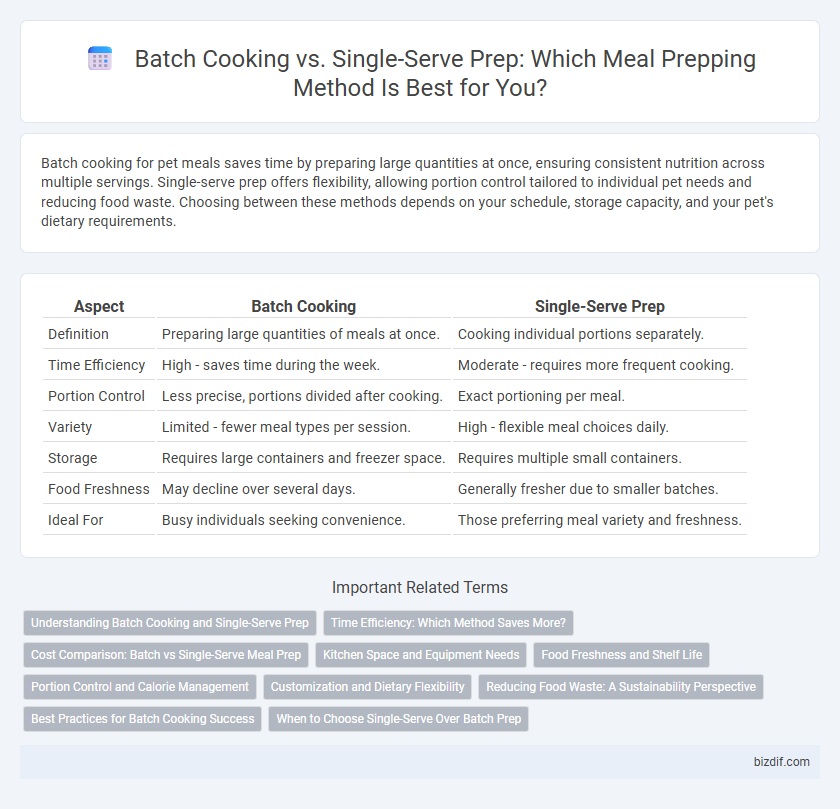Batch cooking for pet meals saves time by preparing large quantities at once, ensuring consistent nutrition across multiple servings. Single-serve prep offers flexibility, allowing portion control tailored to individual pet needs and reducing food waste. Choosing between these methods depends on your schedule, storage capacity, and your pet's dietary requirements.
Table of Comparison
| Aspect | Batch Cooking | Single-Serve Prep |
|---|---|---|
| Definition | Preparing large quantities of meals at once. | Cooking individual portions separately. |
| Time Efficiency | High - saves time during the week. | Moderate - requires more frequent cooking. |
| Portion Control | Less precise, portions divided after cooking. | Exact portioning per meal. |
| Variety | Limited - fewer meal types per session. | High - flexible meal choices daily. |
| Storage | Requires large containers and freezer space. | Requires multiple small containers. |
| Food Freshness | May decline over several days. | Generally fresher due to smaller batches. |
| Ideal For | Busy individuals seeking convenience. | Those preferring meal variety and freshness. |
Understanding Batch Cooking and Single-Serve Prep
Batch cooking involves preparing large quantities of meals at once, which saves time and ensures a variety of ready-to-eat dishes throughout the week. Single-serve prep focuses on portioning individual meals, making it convenient for grab-and-go consumption and precise calorie control. Both strategies optimize meal prepping by balancing efficiency, freshness, and customization to meet different dietary needs.
Time Efficiency: Which Method Saves More?
Batch cooking maximizes time efficiency by preparing large quantities of meals simultaneously, reducing daily cooking time through bulk processing. Single-serve prep demands more frequent cooking but offers customization and freshness for each meal, potentially increasing overall time spent. For those seeking to minimize cooking sessions, batch cooking is typically the more time-saving method.
Cost Comparison: Batch vs Single-Serve Meal Prep
Batch cooking reduces overall food costs by purchasing ingredients in bulk and minimizing waste, making it more economical than single-serve meal prep. Single-serve prepping often requires individualized packaging and smaller ingredient quantities, which can increase per-meal expenses. Economies of scale in batch cooking help optimize budget efficiency for meal prepping.
Kitchen Space and Equipment Needs
Batch cooking maximizes kitchen efficiency by preparing large quantities of meals at once, requiring ample counter space and multiple large storage containers to organize portions. Single-serve prep demands less overall space but needs more specialized equipment such as individual meal prep containers and potentially additional reheating appliances to manage varied portions. Optimizing kitchen layout for batch cooking involves investing in large-capacity cookware and stacking storage, while single-serve prep benefits from modular tools and compact storage solutions.
Food Freshness and Shelf Life
Batch cooking enhances food freshness by preparing large quantities of meals simultaneously, allowing for quicker cooling and freezing times which extends shelf life up to 4-6 days in the refrigerator or 3-6 months in the freezer. Single-serve prep ensures optimal freshness for each portion by reducing exposure to air and repeated reheating, typically maintaining ideal taste and texture for 2-3 days refrigerated. Choosing between batch cooking and single-serve prep depends on balancing convenience with maintaining meal freshness and maximizing shelf life.
Portion Control and Calorie Management
Batch cooking allows for better portion control by preparing large quantities of meals that can be divided into consistent servings, simplifying calorie management throughout the week. Single-serve prep offers precise customization of each meal's ingredients and calories, ideal for tailored dietary needs and avoiding overeating. Choosing between the two depends on individual goals for convenience and exactness in managing daily caloric intake.
Customization and Dietary Flexibility
Batch cooking enables preparing large quantities of meals, ideal for consistent portions and time-saving, but offers limited customization for individual dietary preferences. Single-serve prep allows tailored meals to meet specific dietary needs, such as keto, vegan, or gluten-free, enhancing flexibility for diverse nutrition plans. Choosing between batch cooking and single-serve prep depends on balancing convenience with personalized dietary requirements.
Reducing Food Waste: A Sustainability Perspective
Batch cooking minimizes food waste by using larger quantities of ingredients efficiently, reducing packaging waste and excess food spoilage. Single-serve prep offers precise portion control, preventing leftovers and encouraging consumption of fresh meals. Both methods contribute to sustainability by optimizing ingredient use and minimizing disposable packaging.
Best Practices for Batch Cooking Success
Batch cooking optimizes efficiency by preparing large quantities of meals in one session, reducing daily cooking time and minimizing food waste. Best practices include organizing ingredients by meal type, using airtight containers to maintain freshness, and scheduling cooking sessions to coincide with sales or ingredient availability for cost savings. Prioritizing balanced meals with diverse nutrients and properly labeling meals with dates ensures both health benefits and food safety throughout the week.
When to Choose Single-Serve Over Batch Prep
Single-serve prep is ideal for individuals with unpredictable schedules or those aiming to control portion sizes and calorie intake more precisely. It reduces food waste by allowing for customized meals based on daily preferences or dietary needs, unlike batch cooking which produces large quantities at once. Opt for single-serve prep when flexibility, meal variety, and strict dietary adherence are priorities in your meal planning routine.
Batch Cooking vs Single-Serve Prep Infographic

 bizdif.com
bizdif.com